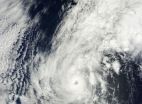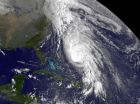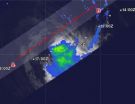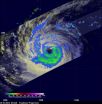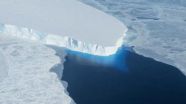(Press-News.org) Cambridge, Mass. - October 16, 2012 - Atmospheric chemists at the Harvard School of Engineering and Applied Sciences (SEAS) have found that when it comes to secondary organic material in the atmosphere, there are two distinct breeds: liquids and jellies.
Secondary organic materials (SOM) are airborne particles that have begun to react with gases in the atmosphere. In the last 20 years' research and climate modeling, these SOM particles have been assumed to drift as liquids. In a liquid phase, the organic materials would absorb other compounds like ammonia or ozone very easily and then progress through a series of chemical changes (known as chemical aging) to form particles that reflect or absorb sunlight, or form clouds.
Now, experiments at Harvard, using particles of α-pinene SOM and adipic acid, have shown that a drop in humidity can send these common aerosols into a jelly-like phase, in which they resist chemical aging almost entirely. The findings, published in the Proceedings of the National Academy of Sciences, may call for a revision of regional and global climate models.
"Our research provides the first experimental evidence that the chemical aging process of atmospheric particles is limited by phase," says principal investigator Scot Martin, Gordon McKay Professor of Environmental Chemistry at SEAS and in Harvard's Department of Earth and Planetary Sciences. "Solid or semi-solid aerosol particles will only react with other molecules at the surface of the droplet, instead of mixing homogeneously. What this means is that the time scale of important chemical aging processes may be much longer than what is reflected in current models."
The two particles chosen for this study, α-pinene and adipic acid, are common in the Earth's atmosphere; α-pinene is essentially a scent released by coniferous trees (including pines—hence the name), and adipic acid comes from both anthropogenic sources (such as car exhaust) and natural chemical reactions.
In the atmosphere, the particles of α-pinene SOM and adipic acid behave rather like gelatin; in moist conditions, the droplets absorb water and remain liquid. In dry conditions, they solidify without crystallizing. Lead author Kuwata Mikinori, a postdoctoral fellow at SEAS, compares these semi-solid atmospheric particles to chunks of tofu, another high-viscosity, amorphous solid.
"If you pour soy sauce onto a block of tofu at room temperature, the liquid will just sit on the surface of the tofu. It won't sink in," Kuwata explains. "But if you cook tofu in a sauce at a high heat for a long time, the tofu will eventually absorb the taste of the sauce. That's the same kind of effect we're seeing in the atmosphere. Eventually these semi-solid aerosols do blend with other reactants, but it takes a long time, a higher temperature, or enough ambient humidity to encourage a phase change back to liquid."
The researchers selected ammonia as the reactant in their study partly because its nitrogen component is easy to detect using mass spectrometry, but also because of its current environmental relevance. Atmospheric ammonia has been on the increase in the past few years as a byproduct of fertilizer use and livestock farming, and as a result of increasing temperatures.
"For the environment, ammonia is a very tricky compound," says Kuwata. "It neutralizes sulfuric acid, helping prevent acid rain, but its nitrogen component can also fertilize open bodies of water, which can be bad news for ecosystems. When ammonia reacts with SOM, it can form ammonium salts, which are thought to affect cloud nucleation activity, and organic nitrogen, which forms light-absorbing compounds."
Martin and Kuwata conducted their experiments in the Harvard Environmental Chamber, a 5-cubic-meter Teflon bag that hangs from the ceiling of an environmentally controlled laboratory room at SEAS. In trials within this chamber, they recreated various atmospheric conditions while adjusting the humidity, and exposed particles of either α-pinene SOM or adipic acid to ammonia for approximately seven minutes.
Following that exposure, they measured the diameter of the resulting particles and determined the mass and composition of each one to understand the extent of chemical aging that had occurred.
"Our results challenge basic assumptions about the rate of chemical reactions in the atmosphere," says Kuwata. "These results ought to change the way we evaluate the impacts of atmospheric aerosol particles on the climate."
INFORMATION:
This work was supported by the U.S. Department of Energy and by a postdoctoral fellowship from the Japan Society for the Promotion of Science.
Jelly-like atmospheric particles resist chemical aging
Findings will affect scientific models of cloud formation and light absorption
2012-10-17
ELSE PRESS RELEASES FROM THIS DATE:
NASA: How do you solve a problem like (Tropical Storm) Maria?
2012-10-17
The song "How do you solve a problem like Maria?" from the famous film "The Sound of Music" comes to mind when looking at NASA satellite imagery of Tropical Storm Maria churning in the western North Pacific Ocean. The answer lies in increased wind shear and cool ocean temperatures – two factors that can weaken the storm, but won't be present over the next day or two.
NASA's Aqua satellite passed over Tropical Storm Maria on Oct. 16 at 0355 UTC, 12:55 p.m. local time Tokyo/Japan (Oct. 15 at 11:55 p.m. EDT) and the Moderate Resolution Imaging Spectroradiometer (MODIS) instrument ...
NASA sees Hurricane Paul 'eye' Mexico's Socorro Island, coastline
2012-10-17
NASA's Aqua satellite captured a stunning image of Hurricane Paul in the eastern Pacific Ocean that revealed Mexico's Socorro Island was just outside of Paul's eye. Now, Paul is expected to track along the Baja California coast, triggering more warnings.
Hurricane Paul is stirring up rough seas in the eastern Pacific Ocean and warnings are posted along Baja California.
A hurricane warning is in effect for the west coast of Baja California from Santa Fe northward to Punta Abreojos. A tropical storm warning is in effect for the west coast of Baja California north of Punta ...
Satellite sees large Hurricane Rafael battering Bermuda
2012-10-17
Hurricane Rafael is a large hurricane and Bermuda has battened down for Rafael's battering today, Oct. 16. NOAA's GOES-14 satellite revealed Rafael's large span that covers several hundred miles and dwarfs Bermuda.
NOAA's GOES-14 satellite captured a visible image of Tropical Storm Rafael in the Atlantic on Oct. 16 at 7:45 a.m. EDT. The image shows the extent of Hurricane Rafael, which is over 410 miles in diameter. That's longer than the distance between Boston and Washington, D.C. The visible image also showed a thick row of clouds northwest of Rafael. Those clouds ...
Cold viruses point the way to new cancer therapies
2012-10-17
VIDEO:
Dr. O'Shea discusses her research.
Click here for more information.
LA JOLLA, CA---- Cold viruses generally get a bad rap----which they've certainly earned----but new findings by a team of scientists at the Salk Institute for Biological Studies suggest that these viruses might also be a valuable ally in the fight against cancer.
Adenovirus, a type of cold virus, has developed molecular tools----proteins----that allow it to hijack a cell's molecular machinery, including ...
NASA sees rainfall pushed away from Tropical Storm Anais' center
2012-10-17
Satellite imagery from NASA's TRMM satellite showed that wind shear is pushing the bulk of rainfall away from the center of Tropical Storm Anais.
When NASA's Tropical Rainfall Measuring Mission (TRMM) satellite passed over Tropical Storm Anais on Oct. 16 at 0654 UTC (2:54 a.m. EDT), light to moderate rainfall was occurring southeast of the center and falling at a rate between .78 to 1.57 inches/20 to 40 mm per hour. The displacement of rainfall from around the storm's center to the southeast indicates moderate to strong northwesterly wind shear.There no areas of heavy ...
NASA satellite indicates Tropical Storm Prapiroon's rains mostly south of center
2012-10-17
Tropical Storm Prapiroon is still meandering in the western north Pacific Ocean, and NASA's TRMM satellite noticed that dry air and wind shear are adversely affecting rainfall north of the storm's center.
NASA's Tropical Rainfall Measuring Mission (TRMM) satellite flew above Prapiroon when it was a typhoon on Oct. 15, 2012 at 0632 UTC (2:32 a.m. EDT). Prapiroon's sustained wind speeds had dropped to 70 knots (~81 mph) with a large and ragged eye being its dominant feature. TRMM's Microwave Imager (TMI) data indicated that the most intense rain bands south of Prapiroon's ...
1 by land and 1 by sea
2012-10-17
NASA's Operation IceBridge got the 2012 Antarctic campaign off to a productive start with a land ice survey of Thwaites Glacier and a sea ice flight over parts of the Bellingshausen Sea.
During the first few weeks of a campaign, IceBridge typically concentrates on sea ice before it begins to melt as spring temperatures rise, but as often happens in the field, the weather had other ideas.
On Oct. 12, the IceBridge team met with meteorologists at the Punta Arenas airport to discuss weather conditions and make a final decision on where to fly. "The forecast for all sea ...
Ice sheet retreat controlled by the landscape
2012-10-17
Ice-sheet retreat can halt temporarily during long phases of climate warming, according to scientists.
A UK team led by Durham University has found that the geometry of channels beneath the ice can be a strong control on ice behaviour, temporarily hiding the signals of retreat.
The findings, which provide the first simulation of past ice-sheet retreat and collapse over a ten thousand year period in Antarctica, shed new light on what makes ice stable or unstable and will help refine predictions of future ice extent and global sea-level rise, the researchers say.
The ...
Using the eye as a 'window into the brain'
2012-10-17
An inexpensive, five-minute eye scan can accurately assess the amount of brain damage in people with the debilitating autoimmune disorder multiple sclerosis (MS), and offer clues about how quickly the disease is progressing, according to results of two Johns Hopkins studies.
"The eye is the window into the brain and by measuring how healthy the eye is, we can determine how healthy the rest of the brain is," says Peter A. Calabresi, M.D., a professor of neurology at the Johns Hopkins University School of Medicine, and leader of the studies described in recent issues of ...
Eco-Conscious Amelie Swimwear to Debut Collection at L.A. Fashion Weekend @ Sunset Gower Studios, October 19, 2012
2012-10-17
Amelie Swimwear, an eco-conscious swim wear line that uses OEKO-TEX Standard 100 certified fabric, limiting the use of certain harmful chemicals, will sashay down the runway, during L.A. Fashion Weekend @ Sunset Gower Studios, October 19-21, 2012
The sixteen piece collection, created by designer Andrea Abaunza, draws from her native Colombia's diverse ecosystems, landscapes, historic and archeological sites, its people and their cultures. Her prints were inspired by such natural wonders as the Rainbow Ameiva whose ombre skin is reflected in the line, and the 14,000 butterfly ...
LAST 30 PRESS RELEASES:
Scientists use ultrasound to soften and treat cancer tumors without damaging healthy tissue
Community swimming program for Black youth boosts skills, sense of belonging, study finds
Specific depressive symptoms in midlife linked to increased dementia risk
An ‘illuminating’ design sheds light on cholesterol
Who is more likely to get long COVID?
Study showcases resilience and rapid growth of “living rocks”
Naval Research Lab diver earns Office of Naval Research 2025 Sailor of the Year
New Mayo-led study establishes practical definition for rapidly progressive dementia
Fossil fuel industry’s “climate false solutions” reinforce its power and aggravate environmental injustice
Researchers reveal bias in a widely used measure of algorithm performance
Alcohol causes cancer. A study from IOCB Prague confirms damage to DNA and shows how cells defend against it
Hidden viruses in wastewater treatment may shape public health risks, study finds
Unlock the power of nature: how biomass can transform climate mitigation
Biochar reshapes hidden soil microbes that capture carbon dioxide in farmland
Reducing saturated fat intake shows mortality benefit, but only in high-risk individuals
Manta rays create mobile ecosystems, study finds
Study: Mixed results in using lipoic acid to treat progressive multiple sclerosis
Norbert Holtkamp appointed director of Fermi National Accelerator Laboratory
New agentic AI platform accelerates advanced optics design
Biologists discover neurons use physical signals — not electricity — to stabilize communication
Researchers discover that a hormone can access the brain by hitchhiking
University of Oklahoma researcher awarded funding to pursue AI-powered material design
Exploring how the visual system recovers following injury
Support for parents with infants at pediatric check-ups leads to better reading and math skills in elementary school
Kids’ behavioral health is a growing share of family health costs
Day & night: Cancer disrupts the brain’s natural rhythm
COVID-19 vaccination significantly reduces risk to pregnant women and baby
The role of vaccination in maternal and perinatal outcomes associated with COVID-19 in pregnancy
Mayo Clinic smartwatch system helps parents shorten and defuse children's severe tantrums early
Behavioral health spending spikes to 40% of all children’s health expenditures, nearly doubling in a decade
[Press-News.org] Jelly-like atmospheric particles resist chemical agingFindings will affect scientific models of cloud formation and light absorption


